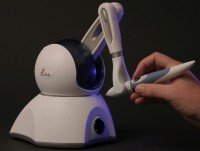Via Wired News
Is it possible to train yourself in a virtual patient?
A short answer is Yes.
In India, Professor Suvranu De is developing a surgery simulator with help of this couple of devices:
Sounds nice, but… I personally believe that you cannot train yourself in a virtual environment because there are not virtual patients nor virtual diseases. There are certain things that cannot be learned that way. Human body and human organs manifest in different ways in disease and wellness, as the number of people on earth.
Here is an example of the SimSurgery:
Have you ever seen a virtual fever or cancer? I don’t.
The basics of minimally invasive surgery skills could be learned in virtual environments (like learn for the first time the spatial skill in angle laparoscopes). From there to the point of learn certain procedure in a simulator, it’s a long way.
Perhaps this kind of technology can have some applications, but we don’t have to hurry and change what it has been proven for years… although somebody call us old fashioned.
What do you think about surgery simulators?
Dr. Jon Mikel Iñarritu


enrico:
It would be a lovely experience.
Dr. Savatta:
That was my point… the less hands on experience.
Kevin:
Thank you for visiting this site. If I will have access for this gadget I could give you my opinion.
I”m not a doctor, but one of those simulators looks likes something I saw at the Pervasive Tech Labs a few years ago when I worked for Indiana University. The one I’m talking about looks like the iMac base w/ a pen in hand.
I don’t know how realistic it was, but you could use it to simulate injecting a syringe into a hand. It was very cool and sort of creepy in its own way.
I think laparoscopic simulators have come a long way and are useful as an ajunct to regular training.
I am only out of training 3 years, but already the majority of my surgery is not open. About 5-10% is open, 5-10% is laparoscopic, and 85% is robotic.
Residents in surgical training have less and less hands on experience. Iva sampled a laparoscopic trainer that is decent. As for open surgery, I havent seen anything yet that is good. Open surgery is easier to learn because the surgeon is there and the assistant is seeing the same thing.
With laparoscopy the surgery has less room for error as one mistake can cause a conversion to open surgery. I think the need in laparoscopy training is more than for open surgery.
I think it’s a positive step in the right direction–let students be the demise of a bunch of virtual patients before attempting to anastomose a bowel in a real pt. However, you make a good point, and to loosely paraphrase Dr. Schwab, the hard part about surgery isn’t the cutting, it’s the instinct, the patient management, the ability to know when to do nothing as well as something. But this isn’t a device to teach people how to be surgeons, it’s just a tool to learn mechanics, and as such, can be a great thing.
I sure would love to get my hands on one and find out just how badly I can mangle some digital viscera. 😉
P.S. Those Crystal Eyes(tm) goggles are amazing. I used to use them often doing molecular modeling on SGI workstations, and watching things rotate and manipulate in 3D is too cool.
I think it’s a very positive thing. And not only does it allow training, some of them can track and record a student’s movements and accuracy, so that progress and level of skill can be objectively measured. It would really be something if such a thing were possible for open surgery.